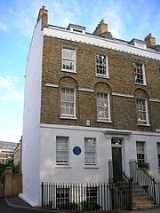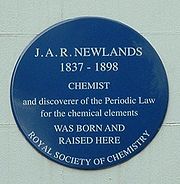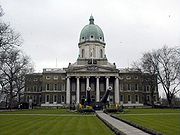
West Square
Encyclopedia



London
London is the capital city of :England and the :United Kingdom, the largest metropolitan area in the United Kingdom, and the largest urban zone in the European Union by most measures. Located on the River Thames, London has been a major settlement for two millennia, its history going back to its...
, England
England
England is a country that is part of the United Kingdom. It shares land borders with Scotland to the north and Wales to the west; the Irish Sea is to the north west, the Celtic Sea to the south west, with the North Sea to the east and the English Channel to the south separating it from continental...
, just south from St George's Road
St George's Road
St George's Road is a road in Southwark, London running between Westminster Bridge Road to the northwest and Elephant and Castle to the southeast. Its name derives from its crossing of St George's Fields, being an open rural area of the parish of St George the Martyr, Southwark...
. The Square is within the London Borough of Southwark
London Borough of Southwark
The London Borough of Southwark is a London borough in south east London, England. It is directly south of the River Thames and the City of London, and forms part of Inner London.-History:...
, but as it is located in postcode it is commonly said to be in Lambeth
Lambeth
Lambeth is a district of south London, England, and part of the London Borough of Lambeth. It is situated southeast of Charing Cross.-Toponymy:...
.
Immediately to the west is the Imperial War Museum
Imperial War Museum
Imperial War Museum is a British national museum organisation with branches at five locations in England, three of which are in London. The museum was founded during the First World War in 1917 and intended as a record of the war effort and sacrifice of Britain and her Empire...
(formerly the Bethlem Royal Hospital
Bethlem Royal Hospital
The Bethlem Royal Hospital is a psychiatric hospital located in London, United Kingdom and part of the South London and Maudsley NHS Foundation Trust. Although no longer based at its original location, it is recognised as the world's first and oldest institution to specialise in mental illnesses....
). To the south is the Imperial War Museum Annex (which used to be an orphans' home) in Austral Street.
The terraced houses in the Square surround a communal garden
Communal garden
A communal garden is a normally formal garden for shared use by a number of local residents, typically in an urban setting. The term is especially used in the United Kingdom...
that is open to the public during the day but locked at night. The Square forms part of a larger conservation area
Conservation area
A conservation areas is a tract of land that has been awarded protected status in order to ensure that natural features, cultural heritage or biota are safeguarded...
.
History
The Temple West family originally owned the land here, hence the name. In 1791, the area was leased for house building. By 1799, the garden in the centre of the Square was finished.In 1812, a tower was built by the Admiralty
Admiralty
The Admiralty was formerly the authority in the Kingdom of England, and later in the United Kingdom, responsible for the command of the Royal Navy...
at 36 West Square for a telegraph using shutters. During the Napoleonic Wars
Napoleonic Wars
The Napoleonic Wars were a series of wars declared against Napoleon's French Empire by opposing coalitions that ran from 1803 to 1815. As a continuation of the wars sparked by the French Revolution of 1789, they revolutionised European armies and played out on an unprecedented scale, mainly due to...
, this transmitted messages between Whitehall
Whitehall
Whitehall is a road in Westminster, in London, England. It is the main artery running north from Parliament Square, towards Charing Cross at the southern end of Trafalgar Square...
and the Royal Navy
Royal Navy
The Royal Navy is the naval warfare service branch of the British Armed Forces. Founded in the 16th century, it is the oldest service branch and is known as the Senior Service...
in Kent
Kent
Kent is a county in southeast England, and is one of the home counties. It borders East Sussex, Surrey and Greater London and has a defined boundary with Essex in the middle of the Thames Estuary. The ceremonial county boundaries of Kent include the shire county of Kent and the unitary borough of...
. In the 1800s, the Square was used to house some staff at the Bethlem Royal Hospital
Bethlem Royal Hospital
The Bethlem Royal Hospital is a psychiatric hospital located in London, United Kingdom and part of the South London and Maudsley NHS Foundation Trust. Although no longer based at its original location, it is recognised as the world's first and oldest institution to specialise in mental illnesses....
(now the Imperial War Museum).
J. A. R. Newlands (1837–1898), the Victorian
Victorian era
The Victorian era of British history was the period of Queen Victoria's reign from 20 June 1837 until her death on 22 January 1901. It was a long period of peace, prosperity, refined sensibilities and national self-confidence...
chemist who discovered the Periodic Law for the chemical element
Chemical element
A chemical element is a pure chemical substance consisting of one type of atom distinguished by its atomic number, which is the number of protons in its nucleus. Familiar examples of elements include carbon, oxygen, aluminum, iron, copper, gold, mercury, and lead.As of November 2011, 118 elements...
s, was born and raised in a house at the south-west corner of the Square. A blue plaque
Blue plaque
A blue plaque is a permanent sign installed in a public place to commemorate a link between that location and a famous person or event, serving as a historical marker....
, installed by the Royal Society of Chemistry
Royal Society of Chemistry
The Royal Society of Chemistry is a learned society in the United Kingdom with the goal of "advancing the chemical sciences." It was formed in 1980 from the merger of the Chemical Society, the Royal Institute of Chemistry, the Faraday Society and the Society for Analytical Chemistry with a new...
, commemorates Newlands on the front of the house.
In 1884–5, the Charlotte Sharman
Charlotte Sharman
Charlotte Sharman was a Christian woman who ran orphanages for girls in West Square Southwark, Gravesend, Hampton and Tunbridge Wells. She, in the course of her lifetime, cared for and educated over 1,200 destitute children...
School was built on the north-west side, named after its founder the Christian philanthropist. It is still located there.
As a young child, Charlie Chaplin
Charlie Chaplin
Sir Charles Spencer "Charlie" Chaplin, KBE was an English comic actor, film director and composer best known for his work during the silent film era. He became the most famous film star in the world before the end of World War I...
(1889–1977) lived at 39 West Square for a short period. He later recalled:
- West Square! At the back of the Bedlam Lunatic Asylum. This is as far back as I can remember as a child. It was there, somewhere around the age of three, we lived in a large house.
At the end of the 19th century, the garden in the Square was threatened with building development, but there was a campaign to keep it. In 1909, the freehold was bought for £3,500 by the London County Council
London County Council
London County Council was the principal local government body for the County of London, throughout its 1889–1965 existence, and the first London-wide general municipal authority to be directly elected. It covered the area today known as Inner London and was replaced by the Greater London Council...
and the Metropolitan Borough of Southwark
Metropolitan Borough of Southwark
The Metropolitan Borough of Southwark was a metropolitan borough in the County of London from 1900 to 1965. It was created to cover the western section of the ancient borough of Southwark and formed the northwestern part of the current London Borough of Southwark. In common with the rest of inner...
. They enlarged and restored the garden, which was then opened for public use in 1910. The Square was scheduled to protect it under the 1931 London Squares Preservation Act. However, after the Second World War, it was proposed that the buildings should be demolished and the area added to Geraldine Mary Harmsworth Park. This was blocked by the Civic Amenities Act and instead the Square became a conservation area. Following the War, the north-west corner of the Square was demolished and prefab houses were built. However, the Square still remains largely intact and of historic interest.

